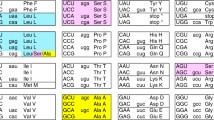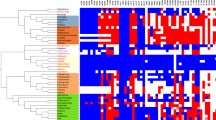Summary
We studied the NAM2 genes of Saccharomyces douglasii and Saccharomyces cerevisiae, and showed that they are interchangeable for all the known functions of these genes, both mitochondrial protein synthesis and mitochondrial mRNA splicing. This confirms the prediction that the S. douglasii NAM2D gene encodes the mitochondrial leucyl tRNA synthetase (EC 6.1.1.4). The observation that these enzymes are interchangeable for their mRNA splicing functions, even though there are significant differences in the intron/exon structure of their mitochondrial genome, suggests that they may have a general role in yeast mitochondrial RNA splicing. A short open reading frame (ORF) precedes the synthetase-encoding ORF, and we showed that at least in S. cerevisiae this is not essential for the expression of the gene; however, it may be involved in a more subtle type of regulation. Sequence comparisons of S. douglasii and S. cerevisiae revealed a particularly interesting situation from the evolutionary point of view. It appears that the two yeasts have diverged relatively recently: there is remarkable nucleotide sequence conservation, with no deletions or insertions, but numerous (albeit non-saturating) silent substitutions resulting from transitions. This applies not only to the NAM2 coding regions, but also to two other ORFs flanking the NAM2 ORF. The regions between the ORFs (believed to be intergenic regions) are much less conserved, with several deletions and insertions. Thus S. douglasii and S. cerevisiae provide an ideal system for the study of molecular evolution, being two yeasts “caught in the act” of speciation.
Similar content being viewed by others
References
Akins, RA, Lambowitz AM (1987) A protein required for splicing Group I introns in Neurospora mitochondria is a mitochondrial Tyrosyl-tRNA synthetase or a derivative thereof. Cell 50:331–345
Banroques, J, Delahodde A, Jacq C (1986) A mitochondrial RNA maturase gene transferred to the yeast nucleus can control the mitochondrial mRNA splicing. Cell 46:837–844
Barnett, JA, Payne RW, Yarrow D (1983) Yeasts: Characteristics and identification. Cambridge University Press, UK
Blanar MA, Sandler SJ, Armengold ME, Ream LW, Clark AJ (1984) Molecular analysis of the recF gene of Escherichia coli. Proc Natl Acad Sci USA 81:4622–4626
Bonitz S, Coruzzi G, Thalenfeld B, Tzagoloff A, Macino G (1980) Assembly of this mitochondrial membrane system: structure and nucleotide sequence of the gene coding for subunit I of yeast cytochrome oxidase. J Biol Chem 255:11927–11941
Carlson M, Botstein D (1982) Two differentially regulated mRNAs with 5′ ends encode secreted and intracellular forms of yeast invertase. Cell 28:145–154
Cech TR, Bass BL (1986) Biological catalysis by RNA. Annu Rev Biochem 55:599–692
Chatton B, Walter P, Ebel JP, Lacroute F, Fasiolo F (1988) The yeast VAS1 gene encodes both mitochondrial and cytoplasmic Valyl-tRNA synthetases. J Biol Chem 263:52–57
Claisse M, Michel F, Hawthorne D (1987) Divergence in mtDNA and effects in interspecific combinations of the nuclear and mitochondrial genomes in the yeast genus Saccharomyces. In: Moose AL, Beechey RB (eds) Plant mitochondria structural, functional and physiological aspects. Plenum Press, New York, pp 283–292
Dale RMK, McClure BA, Houchins JP (1985) A rapid single-stranded cloning strategy for producing a sequential series of overlapping clones for use in DNA sequencing: Application to sequencing the corn mitochondrial 18S rDNA. Plasmid 13:31–40
De la Salle H, Jacq C, Slonimski PP (1982) Critical sequences within mitochondrial introns: pleiotropic, mRNA maturase and cis-dominant signals of the box intron controlling reductase and oxidase. Cell 28:721–732
Delorme MO, Hénaut A, Vigier P (1988) Mutations in the NAM2 genes of Saccharomyces cerevisiae and S. douglasii are clustered non-randomly as a result of constraints on the nucleic acid sequence and not on the protein. Mol Gen Genet 213:310–314
Dujardin G, Pajot P, Groundinsky O, Slonimski PP (1980) Long range control circuits within mitochondria and between nucleus and mitochondria. I. Methodology and phenomenology of suppressors. Mol Gen Genet 179:469–482
Dujardin G, Jacq C, Slonimski PP (1982) Single base substitutions in an intron of oxidase gene compensates splicing defects of the cytochrome b gene. Nature 298:628–632
Dujardin G, Labouesse M, Netter P, Slonimski PP (1983) Genetic and biochemical studies of the nuclear suppressor NAM2: Extraneous activation of a latent pleiotropic maturase. In: Schweyen RJ, Wolf R, Kaudewitz F (eds) Mitochondria 1983. W. de Gruyter, Berlin, pp 233–250
Fayat G, Mayaux JF, Sacerdot C, Fromont M, Springer M, Grunberg-Manago M, Blanquet S (1983) Escherichia coli Phenylalanyl-tRNA synthetase operon region: evidence for an attenuation mechanism. Identification of the gene for the ribosomal protein L20. J Mol Biol 171:239–261
Fitch WM (1986) The estimate of total nucleotide substitutions from pairwise differences is biased. Phil Trans R Soc Lond B 312:317–324
Groudinsky O, Dujardin G, Slonimski P (1981) Long range control circuits within mitochondria, and between nucleus and mitochondria. II Genetic and biochemical analysis of suppressors which selectively alleviate the mitochondrial intron mutations. Mol Gen Genet 184:493–503
Herbert CJ, Labouesse M, Dujardin G, Slonimski PP (1988) The NAM2 proteins from S. cerevisiae and S. douglasii are mitochondrial leucyl t-RNA synthetases, and are involved in mRNA splicing. EMBO J 7:473–483
Ito H, Fukuda Y, Murata K, Kimura A (1983) Transformation of intact yeast cells treated with alkali cations. J Bacteriol 153:163–168
Jacq C, Lazowska J, Slonimski PP (1980) Cytochrome b mRNA maturase encoded in an intron regulates the expression of the split gene: Physical location and base sequence of intron mutations. In: Kroon AM, Saccone C (eds) The organization and expression of the mitochondrial genome. North-Holland Amsterdam, pp 139–152
Kotylak Z, Lazowska J, Hawthorne D, Slonimski P (1985) Intron encoded proteins of mitochondria: key elements of gene expression and genetic evolution. In: Quagliarello E, Palmieri F (eds) Achievements and perspectives in mitochondrial research. Biogenesis vol II. Elsevier Science Publishers, Amsterdam pp 1–20
Labouesse M, Netter P Schroeder R (1984) Molecular basis of the box effect: a maturase deficiency leading to the absence of splicing of two introns located in two split genes of yeast mitochondrial DNA. Eur J Biochem 144:85–93
Labouesse M, Dujardin G, Slonimski PP (1985) The yeast nuclear gene NAM2 is essential for mitochondrial DNA integrity and can cure a mitochondrial RNA-maturase deficiency. Cell 41:133–143
Labouesse M, Herbert CJ, Dujardin G, Slonimski PP (1987) Three suppressor mutations which cure a mitochondrial RNA maturase deficiency occur at the same codon in the open reading frame of the nuclear NAM2 gene. EMBO J 6:713–721
Lazowska J, Jacq C, Slonimski PP (1980) Sequence of introns and flanking exons in wild-type and box3 mutants of cytochrome b reveals an interlaced splicing protein coded by an intron. Cell 22:333–348
Lipman DJ, Pearson WR (1985) Rapid and sensitive protein similarity searches. Science 227:1435–1441
Maniatis T, Fritsch EF, Sambrook J (1982), Molecular cloning. A laboratory manual. Cold Spring Harbor Laboratory Cold Spring Harbor, New York
McGraw P, Tzagoloff A (1983) Assembly of the mitochondrial membrane system: characterisation of a yeast nuclear gene involved in the processing of the cytochrome b pre-mRNA. J Biol Chem 258:9459–9468
Messing J, Crea R, Seabury PH (1981) A system for shotgun DNA sequencing. Nucleic Acids Res 9:309–321
Myers AM, Pape LK, Tzagoloff A (1985) Mitochondrial protein synthesis is required for maintenance of intact mitochondrial genomes in Saccharomyces cerevisiae. EMBO J 4:2087–2092
Nasmyth KA, Reed SI (1980) Isolation of genes by complementation in yeast: Molecular cloning of a cell-cycle gene. Proc Natl Acad Sci USA 77:2119–2123
Natsoulis G, Hilger F, Fink GR (1986) The HTS1 gene encodes both the cytoplasmic and mitochondrial Histidine tRNA synthetases of S. cerevisiae. Cell 46:235–243
Netter P, Carignani G, Jacq C, Groudinsky O, Clavilier L, Slonimski PP (1982) The cytochrome oxidase subunit I split gene in S. cerevisiae. Genetic and physical studies of the mDNA segment encompassing the cytochrome b-homologous intron. Mol Gen Genet 188:51–59
Orr-Weaver TL, Szostak JW, Rothstein R (1983) Genetic applications of yeast transformation with linear and gapped plasmids. Methods Enzymol, 101:228–245
Pape LK, Koerner TJ, Tzagoloff A (1985) Characterisation of a yeast nuclear gene (MST1) coding for the mitochondrial threonyl-tRNA synthetase. J Biol Chem 260:15362–15370
Perler F, Efstratiadis A, Lomedico P, Gilbert W, Kolodner R, Dodgson J (1980) The evolution of genes: the chicken preproinsulin gene. Cell 20:555–566
Poole SJ, Kauvar LM, Press B, Kornberg T (1985) The engrailed locus of Drosophila. Structural analysis of an embryonic transcript. Cell 40:37–53
Sanger F, Nicklen S, Coulsen AR (1977) DNA sequencing with chain terminating inhibitors Proc Natl Acad Sci USA 74:5463–5467
Smith TF, Waterman MS (1981) Comparisons of Bio-sequences. Adv Appl Math 2:482–489
Thomas PS (1980) Hybridization of denatured RNA and small DNA fragments transferred to nitrocellulose. Proc Natl Acad Sci USA 77:5201–5205
Author information
Authors and Affiliations
Additional information
Communicated by W. Gajewski
Rights and permissions
About this article
Cite this article
Herbert, C.J., Dujardin, G., Labouesse, M. et al. Divergence of the mitochondrial leucyl tRNA synthetase genes in two closely related yeasts Saccharomyces cerevisiae and Saccharomyces douglasii: A paradigm of incipient evolution. Mol Gen Genet 213, 297–309 (1988). https://doi.org/10.1007/BF00339595
Received:
Issue Date:
DOI: https://doi.org/10.1007/BF00339595




